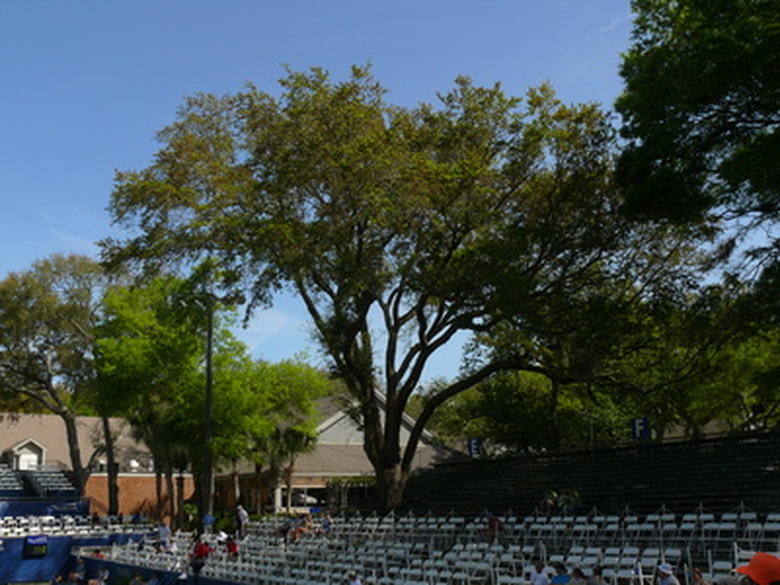Types Of Live Oak Trees
The live oak trees that grow native to the United States are either in the Deep South or in the Far West. The "Trees of North America" field guide states that live oaks are part of the red oak family, but many differ from typical red oaks. The most obvious features the live oaks share is that their leaves are evergreen, remaining on the tree year-round until new ones replace the older foliage.
Live Oak
The live oak (Quercus virginiana) is a tree of the South and regarded as one of the premiere shade species in that part of the country. Live oak grows to around 40 to 50 feet tall, but the tree will develop a spreading crown of thick limbs that are often almost horizontal to the trunk. Found on the coastal plains from as far north as Virginia and south into Texas, live oak has thick and leathery foliage that is elliptical and has a dark green shade. Live oak flourishes in sandy well-drained soil and requires moist ground. The tree will develop in full sun to partly shady conditions and grows relatively fast, despite the fact that the tree can live many centuries. When considering a live oak, you must have an area large enough to support its width when it matures. Live oak wood is one of the heaviest in America. One cubic foot can weigh as much as 55 pounds when dry, according to Floridata.com.
- The live oak trees that grow native to the United States are either in the Deep South or in the Far West.
- Live oak grows to around 40 to 50 feet tall, but the tree will develop a spreading crown of thick limbs that are often almost horizontal to the trunk.
Interior Live Oak
Interior live oak (Quercus wislezini) is native to California and into northern parts of Mexico. This type grows slowly and, while some can be as tall as 75 feet, many are no bigger than a shrub and stand just 10 to 15 feet high. Interior live oak has leaves that stay on the branches for two years before falling off. The leaves resemble those of a holly tree, with an elliptical shape and spiny-toothed edges. Ground squirrels, rabbits, beaver, elk and other animals depend on interior live oak for cover and a source of food. The acorns are 1 inch in length and have a cap that covers half the fruit. The interior live oak will tolerate many kinds of soils, including gravelly loam and clay loam, according to the USDA Natural Resource Conservation Service website. Interior live oak can grow in the shade, especially when it is young, and most grow in soil with a pH level of 5.6 to 7.5.
- Interior live oak (Quercus wislezini) is native to California and into northern parts of Mexico.
- Interior live oak has leaves that stay on the branches for two years before falling off.
Canyon Live Oak
Canyon live oak (Quercus chrysolepis) grows to 80 feet tall and is native to southern portions of Oregon, California, Arizona and sections of New Mexico. Canyon live oak is an important tree in terms of controlling erosion in hilly and mountainous areas. Canyon live oak leaves are darker green above and pale gray on their undersides, with a felt-like texture on their bottoms. The bark on a mature specimen is scaly and grayish-black with many ridges. The acorns are about 1-1/2 inches long and their caps possess what seems like yellowish wool. This feature gave rise to the nickname of golden cup oak for this species. The trunk of a canyon live oak often is short and contorted, with the limbs being massive, giving the tree a unique look. The United States Department of Agriculture Forest Service website declares no oak native to California can grow under a wider variety of conditions. The tree can grow in moist soil, rocky ground, in exposed places and in ravines. Either sunny or shady spots will support a canyon live oak.
- Canyon live oak (Quercus chrysolepis) grows to 80 feet tall and is native to southern portions of Oregon, California, Arizona and sections of New Mexico.
- The trunk of a canyon live oak often is short and contorted, with the limbs being massive, giving the tree a unique look.
